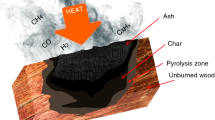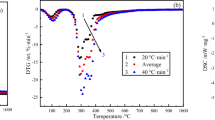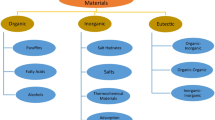Abstract
A general method of thermal analysis is presented, whose aim is to reduce at will pressure and temperature gradients inside the sample submitted to thermolysis. The basic idea is to control the sample temperature so as to keep constant a parameter related to the decomposition rate. Attention is specially called on the case when the controlled parameter is pressure, which allows to monitor at the same time two parameters (pressure and decomposition rate). As an example, one apparatus is described, working in the pressure range between 20 and 10−3 torr. This method of Constant Rate Thermal Analysis (CRTA) appears to be specially suited for thermal analysis under controlled vacuum, for the preparation of well defined porous samples, and for the study of decomposition mechanisms.
Résumé
Une méthode générale d'analyse thermique est proposée, qui a pour premier but de permettre de réduire à volonté les gradients de pression et de température dans la masse de l'échantillon soumis à la thermolyse. Cette méthode consiste à asservir la température de l'échantillon à une grandeur liée à sa vitesse de décomposition. On développe le cas où la grandeur contrôlée est une pression, ce qui permet de fixer simultanément deux paramètres (pression et vitesse de décomposition). L'appareil décrit à titre d'exemple est utilisable aux pressions comprises entre 20 et 10−3 torrs. II est spécialement adapté à l'analyse thermique sous vide contrôlé, à la préparation de solides divisés bien définis et à l'étude de mé canismes de décomposition.
Zusammenfassung
Es wird eine allgemeine thermoanalytische Methode vorgeschlagen, die es gestattet, die Druck- und Temperaturgradienten in der der Thermolyse zu unter werfenden Probe beliebig zu reduzieren, indem die Temperatur der Probe einer durch die Zersetzungsgeschwindigkeit bestimmten Größe zugeordnet wird. Es wird der Fall diskutiert, in dem der Druck die kontrollierte Größe ist und damit gleichzeitig zwei Parameter (Druck und Zersetzungsgeschwindigkeit) zu bestimmen sind. Der beschriebene Apparat ist bei Drücken zwischen 20 und 10−3 Torr. anwendbar und ist besonders zu thermischen Analysen in kontrolliertem Vakuum, zur Herstellung von gut definierten festen Körpern und zum Studium von Zersetzungsmechanismen geeignet.
Резюме
Описан общий метод те рмического анализа, ц ель которого — снижение, п о желанию, давления и гр адиента температуры внутри образца, подвергнуто го термолизу. Основной концепцией является измерение т емпературы образца таким образо м, чтобы параметр, относящийс я к скорости распада б ыл постоянным. Обращает ся внимание на тот случай, когда давлени е является контролир уемым параметром, что позво ляет определять направление двух пар аметров одновременн о (давление и скорость распада). Опи сана установка, работающая в области давления между 20—10−3 мм рт. ст. Она подходит для проведе ния термического анализ а под контролируемым вакуумом, для приготовления об разцов, обладающих хорошо вы раженной пористость ю, и для изучения механизма р аспада.
Similar content being viewed by others
Bibliographie
P. D. Garn etJ. E. Kessler, Anal. Chem., 32 (1960) 1563.
P. D. Garn, Anal. Chem., 33 (1961) 1247.
H.Mauras, Bull. Soc. Chim. France, (1954) 762.
J.Guenot, J. L.Valicon et G.Pannetier, Bull. Soc. Chim. France, (1967) 3068.
R. F. Horlock, P. L. Morgan etP. J. Anderson, Trans. Faraday Soc., 59 (1963) 721.
M. Lebailly, Rev. Mater. Construct. Trav. Publ., 615 (1966) 496.
M. H.Simonot-Grange, G.Watelle-Marion et A.Cointot, Bull. Soc. Chim. France, (1968) 2747.
P.Barret, Proc. 4th Int. Symp. React. Solids, Amsterdam, (1960) 178.
P. J. Anderson, R. F. Horlock etR. G. Avery, Proc. Brit. Ceram. Soc., 3 (1965) 33.
H.Mauras, J. Chim. Phys., (1963) 1419.
M. Smoluchowski, Bul. Acad. Sci., Crac, Ser. A, (1910) 129; (1911) 548.
R.Cohen-Adad, communication orale à la Société Chimique de France, Paris 13 Octobre 1967.
A. L.Reimann, “Technique du vide”, Dunod éd., Paris, (1956) p. 13.
P. Dugleux etJ. L. Doremieux, Compt. Rend., 263 (1966) 293.
J.Rouquerol, Proceedings of the 2d International Conference on Thermal Analysis Worcester, U.S.A., Academic Press. vol. I, pp. 281–8.
J. Kermarec, J. Fraissard, J. Elston etB. Imelik, J. Chim. Phys. 65 (5) (1968) 920.
J.Mayet, J.Rouquerol, J.Fraissard et B.Imelik, Bull. Soc. Chim. France, (1966) p. 2805.
A. Baumer etM. Ganteaume, Compt. Rend. 266 (1968) 120.
J.Rouquerol, Thèse de Doctorat, Paris, (1964).
G.Chottard, J.Fraissard et B.Imelik, Bull. Soc. Chim. France, (1967) 4331.
Author information
Authors and Affiliations
Rights and permissions
About this article
Cite this article
Rouquérol, J. L'analyse thermique a vitesse de decomposition constante. Journal of Thermal Analysis 2, 123–140 (1970). https://doi.org/10.1007/BF01911343
Received:
Issue Date:
DOI: https://doi.org/10.1007/BF01911343




